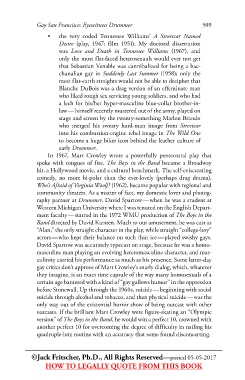Page 529 - Gay San Francisco: Eyewitness Drummer - Vol. 1
P. 529
Gay San Francisco: Eyewitness Drummer 509
• the very coded Tennessee Williams’ A Streetcar Named
Desire (play, 1947; film 1951). My doctoral dissertation
was Love and Death in Tennessee Williams (1967), and
only the most flat-faced heterosexuals would ever not get
that Sebastian Venable was cannibalized for being a bac-
chanalian gay in Suddenly Last Summer (1958); only the
most flat-earth straights would not be able to decipher that
Blanche DuBois was a drag version of an effeminate man
who liked rough sex servicing young soldiers, and who had
a lech for his/her hyper-masculine blue-collar brother-in-
law — himself recently mustered out of the army, played on
stage and screen by the twenty-something Marlon Brando
who merged his sweaty hard-man image from Streetcar
into his combustion-engine rebel image in The Wild One
to become a huge biker icon behind the leather culture of
early Drummer.
In 1967, Mart Crowley wrote a powerfully pentecostal play that
spoke with tongues of fire. The Boys in the Band became a Broadway
hit, a Hollywood movie, and a cultural benchmark. The self-eviscerating
comedy, no more bi-polar than the ever-lovely (perhaps drag drama),
Who’s Afraid of Virginia Woolf? (1962), became popular with regional and
community theaters. As a matter of fact, my domestic lover and photog-
raphy partner at Drummer, David Sparrow — when he was a student at
Western Michigan University where I was tenured on the English Depart-
ment faculty — starred in the 1972 WMU production of The Boys in the
Band directed by David Karsten. Much to our amusement, he was cast as
“Alan,” the only straight character in the play, while straight “college-boy”
actors — who kept their balance on such thin ice — played swishy gays.
David Sparrow was accurately typecast on stage, because he was a homo-
masculine man playing an evolving heteromasculine character, and mas-
culinity carried his performance as much as his presence. Some latter-day
gay critics don’t approve of Mart Crowley’s snarly dialog, which, whatever
they imagine, is an exact time capsule of the way many homosexuals of a
certain age bantered with a kind of “gay gallows humor” in the oppression
before Stonewall. Up through the 1960s, suicide — beginning with social
suicide through alcohol and tobacco, and then physical suicide — was the
only way out of the existential horror show of being outcast with other
outcasts. If the brilliant Mart Crowley were figure-skating an “Olympic
version” of The Boys in the Band, he would win a perfect 10, crowned with
another perfect 10 for overcoming the degree of difficulty in nailing his
quadruple-lutz routine with an accuracy that some found disconcerting.
©Jack Fritscher, Ph.D., All Rights Reserved—posted 05-05-2017
HOW TO LEGALLY QUOTE FROM THIS BOOK

